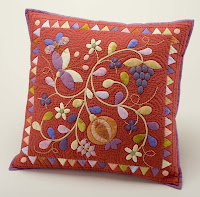
Isn’t the cover quilt for the November issue of American Quilter great? It’s Circle of Fire, designed and foundation pieced by Pat Wolfe.
As pattern editor for American Quilter, I get to see all these great quilts before you do. It is my job, among other things, to make sure that dimensions for pieces, borders, appliqué, etc. are correct. I’ve been a quilter for a long time but I am constantly learning new things. While working with this pattern, I became puzzled about why the diameter of the hole in the black frame around the pieced circle needed to be 1” smaller diameter than that of the unfinished pieced circle. This seemed to be too small an opening. I talked with Pat and thought about this for a long time before I came up with the following explanation that makes it clear for me. Suppose the diameter of your unfinished circle piece is 4½”. Subtract 1/2” for the seam allowance all around and the finished circle piece size will be 4”. If I cut a 4”diameter round hole in the middle of the frame, the raw edge of the hole will just fit around the finished circle, but it can’t be stitched to the circle because there is no seam allowance. To add the seam allowance I must reduce the size of the hole by 1/2” (two 1/4” seam allowances). I must cut a hole that is 3½” in diameter. This is 1” smaller than the original unfinished circle size.


(Submitted by Marje Rhine, AQ Pattern Editor)




.jpg)


